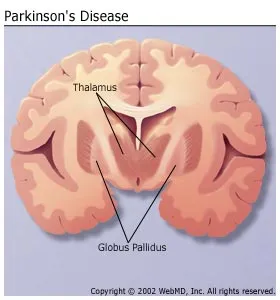Parkinson’s disease is a movement disorder that progresses slowly. Some people will first notice a sense of weakness, difficulty walking, and stiff muscles. Others may notice a tremor of the head or hands. Parkinson’s is a progressive disorder and the symptoms gradually worsen. The general symptoms of Parkinson’s disease include:
- Slowness of voluntary movements, especially in the initiation of such movements as walking or rolling over in bed
- Decreased facial expression, monotonous speech, and decreased eye blinking
- A shuffling gait with poor arm swing and stooped posture
- Unsteady balance; difficulty rising from a sitting position
- Continuous “pill-rolling” motion of the thumb and forefinger
- Abnormal tone or stiffness in the trunk and extremities
- Swallowing problems in later stages
- Lightheadedness or fainting when standing (orthostatic hypotension).
Treatments:
What Is Pallidotomy?
It is thought that the part of the brain called the globus pallidus becomes overactive in Parkinson’s disease. This overactivity acts like a brake and slows or diminishes bodily movement. Pallidotomy surgery permanently destroys the overactive globus pallidus to lessen the symptoms of Parkinson’s disease. This treatment can eliminate rigidity and significantly reduce tremor, bradykinesia, and balance problems. Pallidotomy can also enhance the effect of medication in people with an advanced form of the disease.
What Is Thalamotomy?
It is thought that the abnormal brain activity that causes tremor is processed through the thalamus. Thalamotomy destroys part of the thalamus to block the abnormal brain activity from reaching the muscles and causing tremor. Because thalamotomy is used only to control tremors, it is not generally recommended as a treatment for Parkinson’s disease.


Post a comment